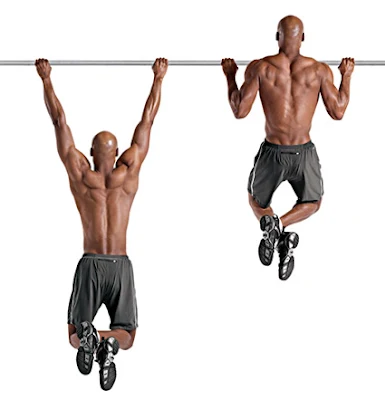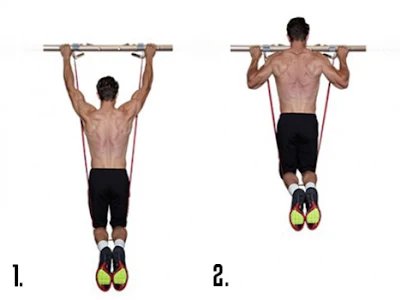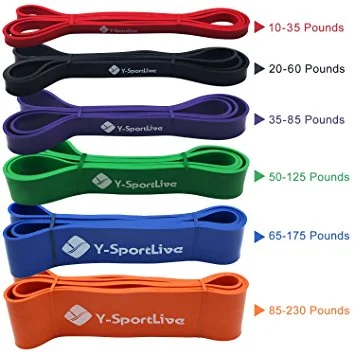The pull-up, which is by far the most effective upper back developing exercise, because it achieves the maximum possible neuromuscular activation, unlike all the other exercises which don’t have this effect on your back.
The pull-up is a test of both physical and mental, but it’s regarded as an exercise that can test exactly how much functional strength you have. This is because it measures strength to weight ratio in a better fashion than other exercises for your back.
However, when you look at the numbers you will see that most people, men and women, can’t do a single pull-up! If you want to build muscle mass on your upper body and boost your upper body strength as much as possible, you want to look at these five tips that you can use to achieve your goals.
1. Resistance Bands
Doing pull-ups is basic when it comes to the level of strength you need to have to achieve them. You should use assisted pull-up machines or bands when starting. When you use assisted pull-up machines, they don’t make use of your upper back muscles which have a role to stabilise your body.
When you use resistance bands they help you recuperate, adding momentum to the upward movement of the pull-up (concentric part), which is the hardest. Sometimes, that little momentum is all that you need to complete your pull-up.
When buying resistance bands, know what you want, you can discern them by colour, which indicates different tension.
- Yellow is the weakest, with least resistance.
- Blue, black and orange offer the most tensile strength.
- If you want something in between, go for red and green,
If you’re just starting now, make sure to pick one that will let you do at least five pull-ups. When you reach the ability to do 12 of them, get a lighter resistance band and start over until you can do them without bands.
2. Functional Strength
If you want to be able to do a consistent number of reps, you will need to learn to do them on your own! You have to become stronger instead of stagnate in one place. Building strength can only be come when you’re exercising at the very least at 80% of your maximum effort.
Try some bent-over or inverted rows or some TRX rows to pump up your intensity and build more strength. You can also try some other varied exercises. Eccentric pull-ups have also been observed to be a great path to building strength.
To do them:
- Lower yourself slowly until you straighten your arms.
- Jump up and do it again.
- Your muscles will always have more power when you’re going down so it shouldn’t be too hard.
I suggest you start with three to six seconds of descending and increase that time as you continue your workouts. When you can do at least six eccentric pull-ups with decent control over your body, you should now be able to do a full pull-up by yourself!
3. Grip Variation
Your back has a lot of muscles, they are all differently activated. However, when you switch up your grip, you can activate as many of them as possible and it will also help you prevent overuse injuries as well as burn out.
There are a lot of grips to choose from and they all do something better than the others:
- The pronated grip has your palms facing away from you.
- The supinated grip has your palms facing towards you.
When using a supinated grip, the area on your upper back which has been targeted will be changed and the intensity will also transfer on the biceps brachii.
The supinated grip is also one of the best for activating the latissimus dorsi and upper arms, even if it is the most basic method of them all. Sometimes, you might get tired or your grip might get sloppy. To remedy this, get some chalk or some wrist straps.
This is a favoured method amongst trainees since it lets them lift more and finish their sets even if their forearms are becoming tired before their upper backs. If you’re doing a lot of exercising, using chalk or some wrist straps will help you get to your goals and even surpass them.
4. Rep Range Variation
You need a lot of strength and endurance to do pull-ups and both of these things are created with vastly different rep ranges. Strength requires low reps, whereas endurance needs high reps to be built.
This means that you should be getting some dip belts, resistance bands and weighted vests to help out. To build strength, exercise for about four weeks with a dip belt, ranging from four to six reps per set.
To build endurance, get some resistance bands and exercise with 10-15 reps per set. You will need the resistance bands and a variety of them because using the different tensile strengths correctly, you can achieve results and increase your rep numbers with incredible speed.
5. Technique and Form Matter
Get your technique straight in order to make any progress, and this counts for any exercise.
- You should begin from a dead hang position, where your shoulders are close to your ears and with your arms completely straight, with retracted shoulder blades.
- When you start pulling, squeeze your abs, keep your eyes on the bar above you and push your chest up.
- Pull towards the bar and keep your chest in the driver’s seat, while your legs should be in a straight line with your torso as much as possible.
- If your chin passes the bar or your chest reaches it, stop and observe the contraction.
- Then, start lowering yourself with as much control as you can muster, until you reach the point that you started from, with your arms straight and you shoulders retracted.
- Finally, make sure that your shoulder blades are tight because if you try to do a pull-up with a loose shoulder girdle, you might get yourself a rotator cuff injury.
These five tips should help you do pull-ups as much as you want. Just make sure to train with consistency and you will be well on your way to doing some great pull-ups.
No Pain No Gain......





